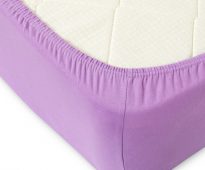 How to fix the sheet on the mattress so that it does not slip
How to fix the sheet on the mattress so that it does not slip
What fabric is best for bed linen
You do not know how to choose the right bedding, where to start and what to pay special attention to? Start by selecting the right fabric. This is the main criterion that affects the quality and performance of the product.
Content
Selection criteria
The selection of the basis for textiles, as well as the kit itself, must be approached systematically, and there are several criteria that must be met.
- Good quality. Do not spare money for a quality product. Only in this way it will last a long time and will not cause problems in use. When you buy a poor-quality foundation, you lose money and give yourself a lot of problems.
- Environmental friendliness. This criterion is also worth paying attention to, but here the choice is yours. Based on your own preferences, as there are decent and natural, and artificial fabrics.
- Manufacturer. Better to trust a trusted company. It is not necessary to buy an advertised brand product, but prefer a well-known manufacturer who has customer reviews.
Now you can proceed to a detailed analysis of options for sewing good bed linen.
What sew bed
To determine which fabric is best for bed linen you need to understand from what it can be made. In the most general sense, sleeping textiles can be made from natural and artificial bases. Each of them has its pros and cons.
| The foundation | Natural | Artificial |
| a brief description of | Fibers are harvested by collecting natural raw materials. | The threads are made primarily of petroleum products. |
| Virtues | Hypoallergenic, well breathable, often hygroscopic | Unpretentious care, almost no rumple, do not paint, have a large selection of color design |
| disadvantages | Strongly crumple, fade, require special mode of operation | Can accumulate static electricity, cause an allergic reaction |
Each of the groups presented contains several options.
Natural base
Often, high-quality bedding is associated with materials in this category. Many people prefer this particular category to create textiles. This is primarily due to the environmental friendliness of the product. Also important are the technical characteristics of natural fabrics: wear resistance, strength, durability, hypoallergenicity (which is important for children). This category has 9 options.
Calico
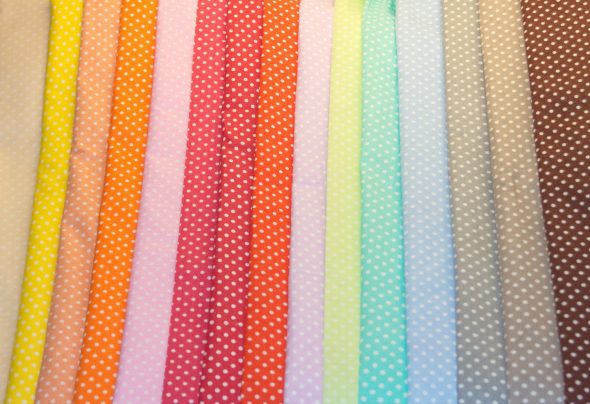
Calico - thick cotton fabric, which is considered to be quite durable and most unpretentious.
The most common and loved by many option. According to external data recalls flax. The coarse calico is made using a special weave of threads - a double mesh. Because of this, it is particularly strong and durable. This method of weaving allows you to prevent the formation of holes in specially used areas. Thus, textiles from calico are extremely durable and have a long service life.
Also products from calico provide any colors.Within different lines, we can meet 3D-images, a variety of prints, patterns and much more. Unlike flax, which provides mostly brown and grayish colors, the calico is easily dyed and can offer many different designs.
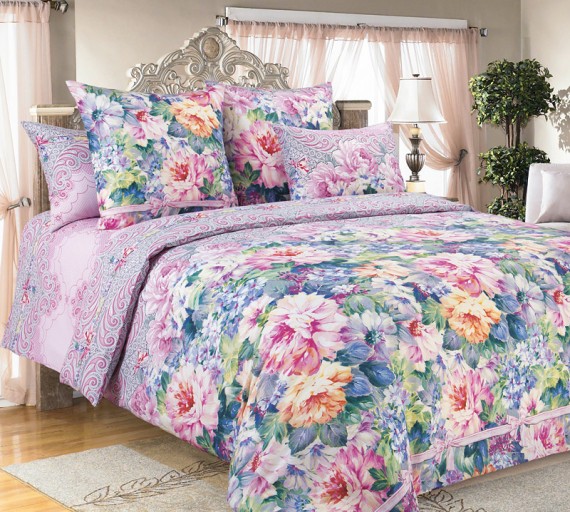
Bed linen from “Love” coarse calico - high-quality, comfortable and wear-resistant
Satin
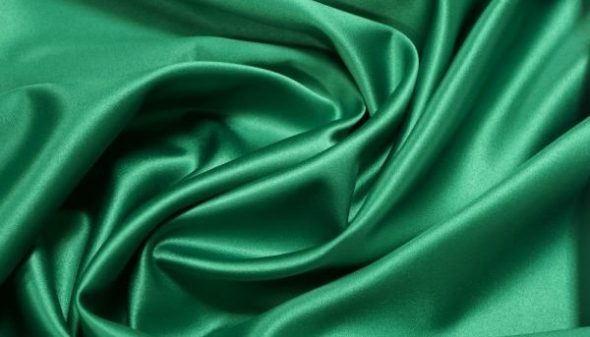
Satin is a brilliant natural fabric, made on the basis of cotton, pleasant to the touch, and has a smooth surface.
Looking for the perfect bedding, then do not go around the side of satin. This is a great option, it is used for both luxury and less expensive options, it all depends on the design and fabric density. Density can vary from 120 g per m2.
Due to the high density and special weave of threads, satin is very durable. Also the way of weaving provides smoothness and gloss from the outside, and roughness and dullness from the inside. This is important when using the product: thanks to its structure, it will not slide off the mattress, but it is good to bond with it. This fabric is classified as expensive.
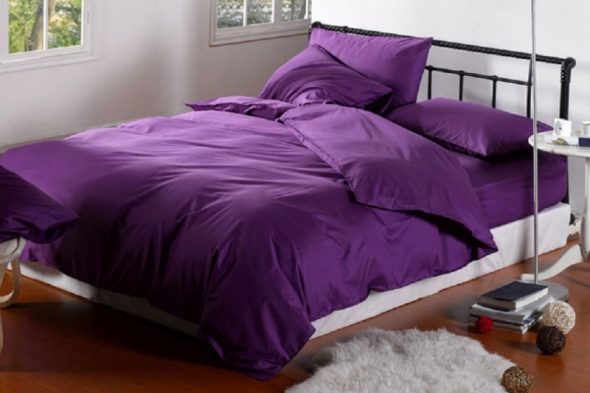
The bedding set of the famous brand Luxe-bed, which is made of satin fabric, preserves the brightness of the pattern and impeccable appearance for a long time.
Poplin

Poplin is made mainly of cotton and has a certain structure of weaving.
Poplin is also 100% cotton, differs from previous versions only in the way weaves. It is he who determines the appearance and characteristics of the product. So, poplin has a certain shine (but not as pronounced as that of satin), its back side is also rough and the sheets do not slide off the mattress.
Poplin well absorbs moisture and retains heat, does not wrinkle, does not fade during washing, does not shrink and does not stretch with time. Its wear resistance is inferior to satin, but this is offset by the price, since satin is more expensive.
Thus, poplin is an excellent option for those who are looking for a good product for a reasonable amount.

Bed linen from poplin on durability is not inferior to linen from calico, but more pleasant to the touch and much softer
Chintz
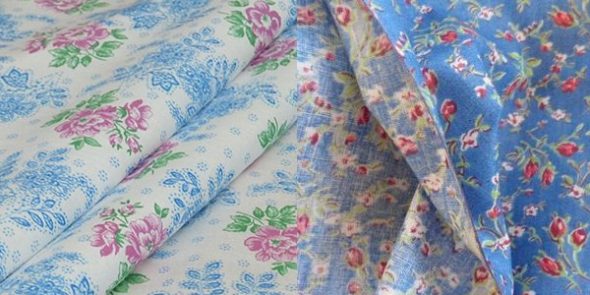
Chintz - one of the best inexpensive materials for the summer heat
Our grandmothers when choosing good bed linen necessarily preferred chintz. Until some time he was the most popular for the manufacture of textiles. Such popularity was justified primarily by the price of the goods, because chintz is inexpensive. Along with this, it has good technical characteristics of the material: hygroscopicity, hypoallergenicity, good air permeability, and the chintz is an environmentally friendly product.
Among the disadvantages of chintz stands out its low strength. The density of this material is up to 100 g per m2. Because of these indicators, he quickly wears out, it forms the pellets and small holes. Also chintz sheds, which is bad for the brightness of the design.
Important!
Chintz fade in the sun, so it is not recommended to leave it under direct rays.
The fineness of calico plays a good role in the summer time. This material is often used for sewing children's textiles, as it is lightweight, well absorbs moisture and passes air.
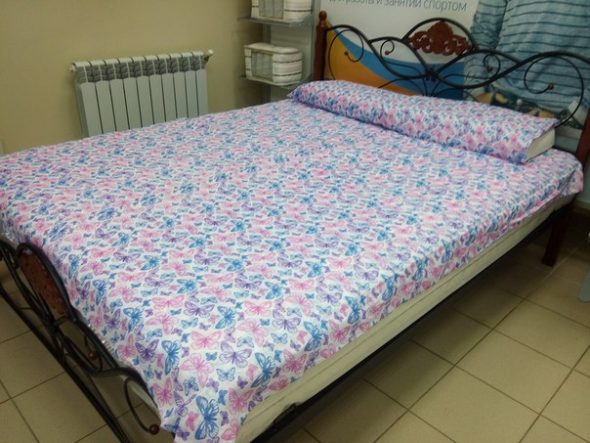
Bed linen from cotton fabric is suitable for short use - in the country, for guests or as a backup option.
Cotton cambric
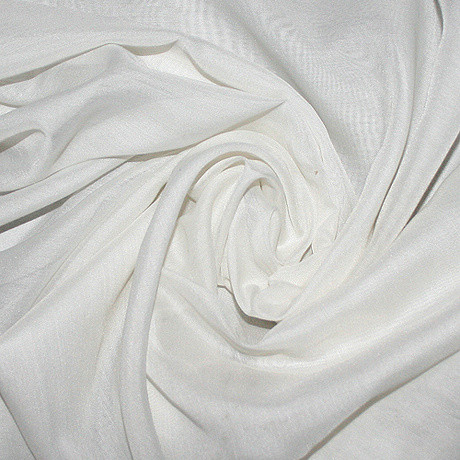
Refined and sophisticated, light and airy cambric is one of the most beautiful fabrics
Baptiste has long been famous for elegance, lightness and luxury. It is a smooth fabric, has an air interlacing of fibers, due to which its specific weight is rather low. But, despite this feature, it is durable and durable (unlike calico).
Due to the structure of the threads, the batiste is very breathable, and in the summer you will never feel hot under such a duvet cover (unlike satin). Of the minuses, you can highlight the high cost.It is also undesirable to use it in the winter period of time, since it is rather light, it is better to resort to warmer options.

Expensive batista bedding for special occasions, but not for everyday use
Percale
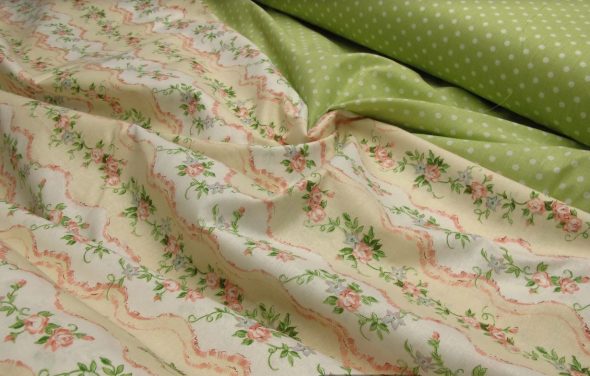
Percale is a surprisingly durable natural fabric with an unusual weaving of threads that are connected using a special solution.
Percale is of different types. Flax is added to one, and it has the appropriate appearance, in the other - silk, which, accordingly, glitters and shines. One of the subspecies visually and feels like a bolon. Once percale was even used for technical purposes. But now we are talking about those subspecies that are suitable for creating good bedding.
It is best to choose a percale with the addition of natural threads. Adding silk is perfect for an exquisite set. In general, in the manufacture of percale weave untwisted yarns. This ensures its smoothness, durability and long-term.

The main advantage of percale bedding sets is durability and resistance to loss of appearance
Knitwear
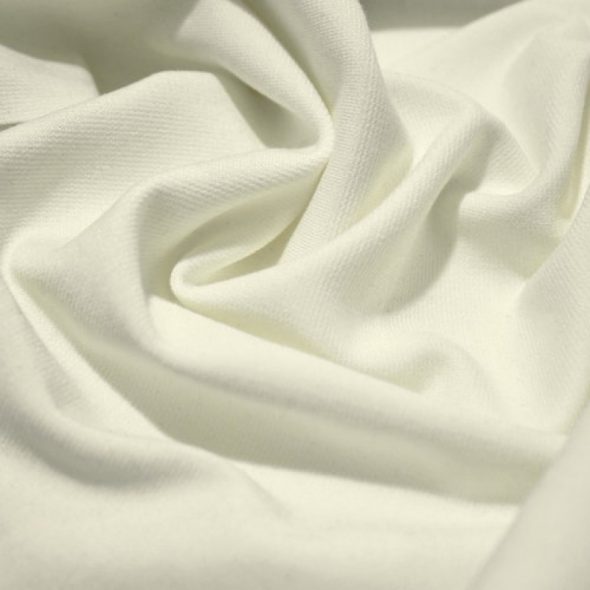
Jersey jersey fabric - a practical, durable option
Knitwear is a very practical material. It allows you to make any design (embroidery, embossing, etc) and addition (pockets, elastic, etc). It does not crumble, does not stretch and does not shrink. This is a great option of medium quality, quite popular and has a low price.
Knitted underwear is common and can be found in any home textile store. You can choose any design and size. But cotton jersey can not serve you for a long time.
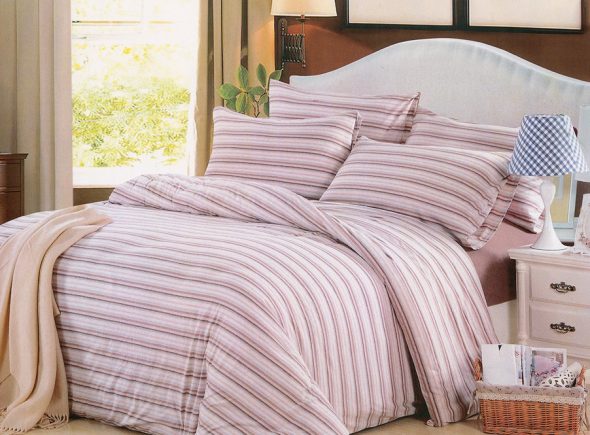
Jersey-knit fiber, which has the elasticity and ability to stretch and is great for bed sets
Linen
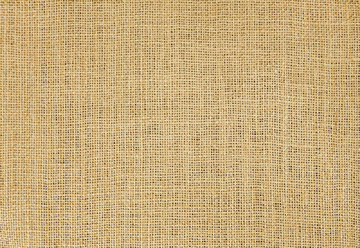
Linen fabric is a fabric with a smooth surface and a matte sheen, which is obtained from flax
Excellent hard and heavy-duty material, has long been valued in Russia. Some buyers consider its rigidity to be a disadvantage, however, in the process of using flax it can acquire softness. Choose linen bedding with additions of other threads and use the conditioner after washing. These simple actions will make the soft comfortable, and at the same time it will remain very strong and durable.
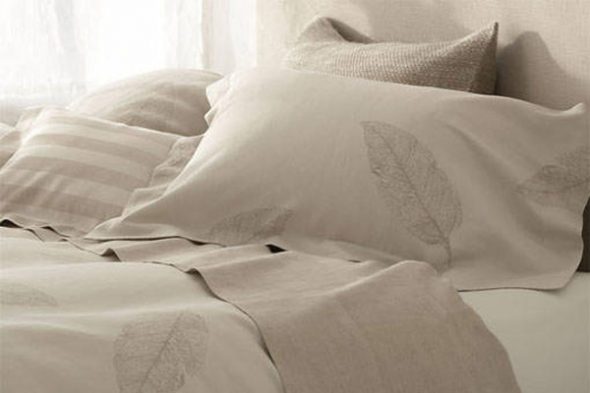
Linen bed linen is suitable for those who prefer high-quality natural materials.
Silk
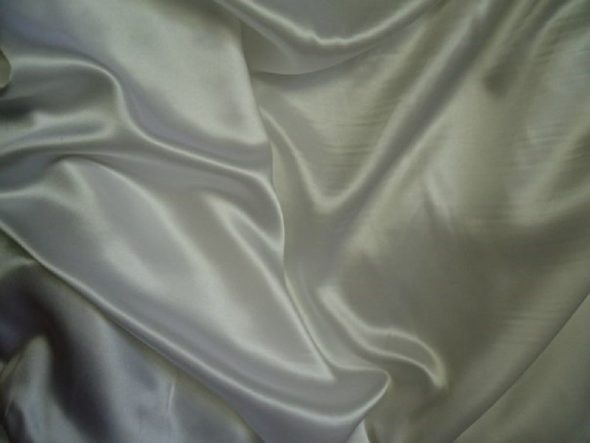
Silk is a natural fabric that is known for its lightness, smoothness and, of course, for its beautiful iridescent radiance.
Used to create luxury kits. It has a luxurious look and a high price. Silk is very soft to the touch, smooth and not very pronounced gloss.
On a note!
Silk does not slip much.
The high cost of material due to the method of extraction of raw materials. The basis for the creation of cloth produce silkworms. To do this, it is necessary to keep the whole farm and collect material. Then the raw material is transported to the factories, where cloth is woven from it by hand.
This material is not very durable. It is very light, airy and soft. There are easy hooks on it. However, there are no pellets on silk products, it does not shrink, does not make up, and with proper care will last a long time.
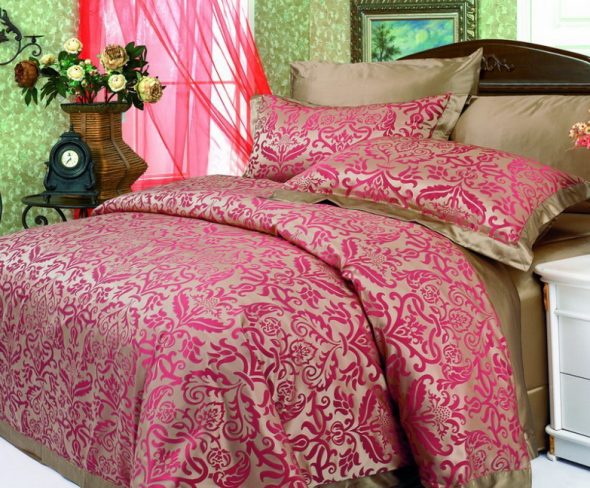
Exquisite natural silk bedding with a stunningly beautiful pattern
Artificial base
This category is often associated with negative reviews. However, this is a misconception. There is a sufficient number of artificially created fabrics, perfectly suited for sewing sleeping textiles. The only disadvantage of such a framework is that they can cause an allergic reaction due to non-ecology. For this reason, they are practically not used for sewing children's textiles. However, people who are not prone to allergies have nothing to fear, and they will find many positive aspects in the textiles of this category.
Rayon
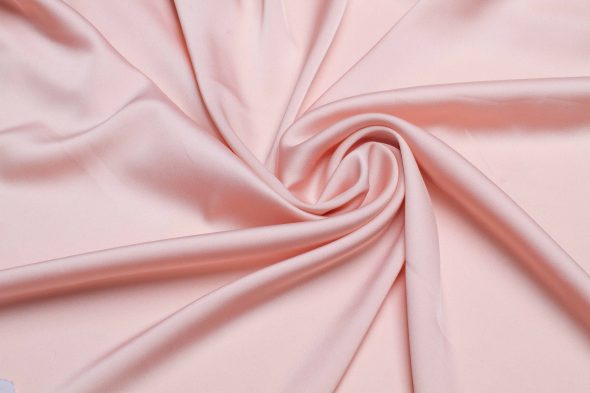
Rayon is a soft fabric made from mercerized cotton, viscose or synthetic fiber.
In contrast to natural, we distinguish this type of silk, from which you can also create good bedding. The quality, of course, it will be different, however, and in the price category will be much lower.
Modern artificial silk is not inferior to the natural in appearance and sensations. But in terms of technical characteristics, it is significantly different: it can sit down after the first wash, it fades in the sun, sprinkles. If you want to create a luxurious atmosphere in the bedroom, without spending a lot of money on it - artificial silk is well suited for this purpose.
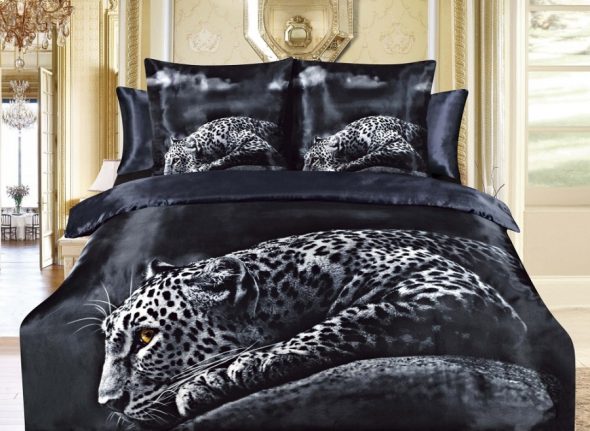
Beautiful 3-D Artificial Silk Bed Set
Microfiber
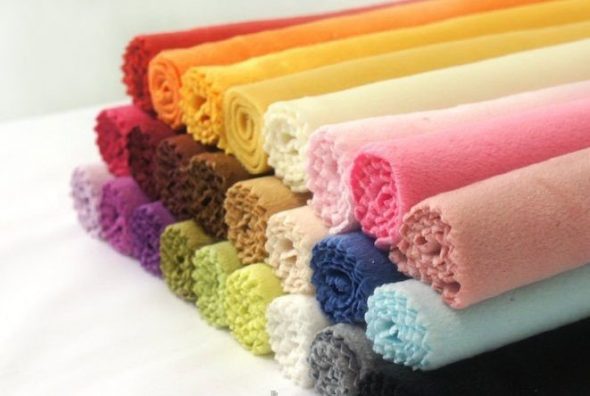
Microfiber or microfiber - a hypoallergenic fabric consisting of nylon fibers, polyester and other polymers
This material, which includes polyamide and polyester. Sometimes there are cotton additives, but most often microfiber is a fully synthetic product created from petroleum products.
Its advantages are that it:
- not wrinkled;
- does not fade;
- not painted;
- does not sit down;
- not wrinkled;
- does not fade.
These advantages are peculiar to many artificial materials, for which they are valued. Unlike many synthetic materials, microfiber is hypoallergenic. One of its main advantages is that it perfectly absorbs moisture and retains heat. For this reason, it is often used to make children's textiles and blankets for the winter period.
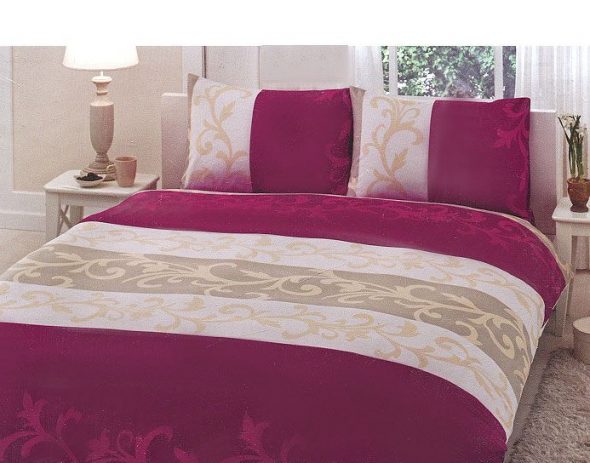
Double bed set “microfibre“ Selena ”
Blend basics
The third group contains the characteristics of the previous two. Blended fabrics are made by mixing natural and artificial yarns. Depending on the species, the first or second may prevail. This, in turn, affects the characteristics and quality of the product. When choosing bed linen, be sure to pay attention to this category. It has excellent performance, and can accommodate various requests, so in this section you will find a decent option.
Atlas
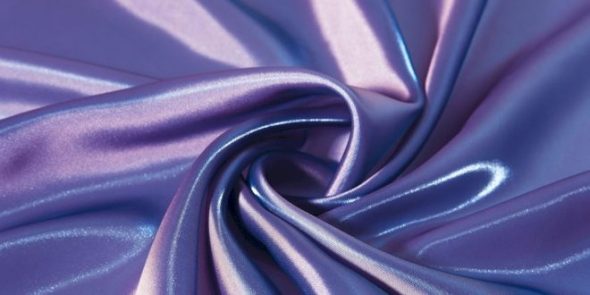
Atlas is created using a special type of weaving - satin or satin
The first, very common example is the atlas. It has a beautiful appearance that is not inferior to silk. In the manufacture of satin using natural silk thread, adding cotton or viscose. The advantage are synthetic threads, silk added only to give the appropriate appearance.
The atlas has a shiny appearance from the front, and a matte one from the back. It slides nicely on the skin, but it keeps well on the bed. Its glossy shine will give the bed a luxurious look. Satin is a great alternative to natural silk. And in comparison with the artificial price is lower.
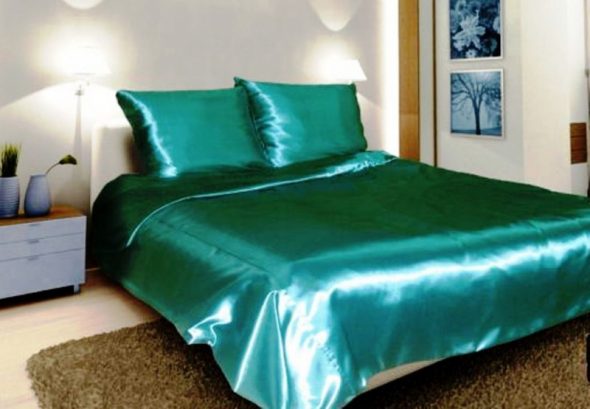
Chic turquoise satin bedding set
Polycotton jacquard
This category is an amateur. Each of them has its positive aspects.
Polycotton is a blend of cotton and polyester. Due to this composition, it is hypoallergenic, lends itself well to cleaning, does not hesitate, has high wear resistance.
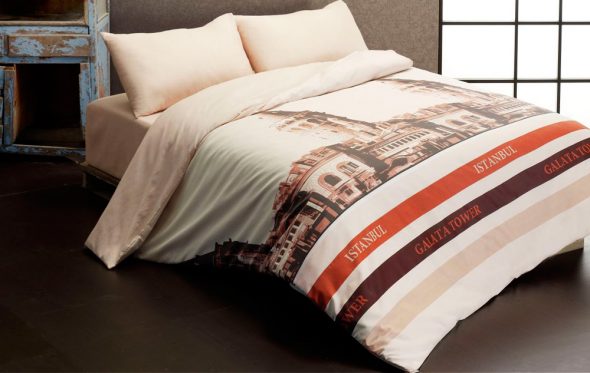
Polycotton underwear is beautiful, pleasant to the touch, inexpensive and easy to clean.
Previously, jacquard was used for upholstery in the royal chambers. Consequently, expensive and luxurious. It has a shiny appearance with a pattern, which is obtained by the special interweaving of the threads.

Jacquard bedding with embroidery will fit perfectly into a classic bedroom
Now you know how to choose bedding according to the criterion of fabric manufacture. This is an important factor, giving an extensive selection. Each of the possible options has been clarified, and now you can easily select the right product.
Do not forget that when buying a product it is imperative to carefully inspect it for defects, check the manufacturer and brand (especially when you buy a branded product). Check the quality and you will never be deceived.
Video: How to choose bedding?
 How to fix the sheet on the mattress so that it does not slip
How to fix the sheet on the mattress so that it does not slip
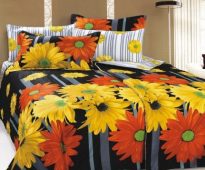 Bed Size Table
Bed Size Table
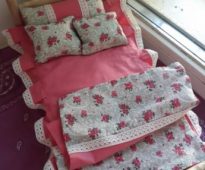 Bedding for dolls
Bedding for dolls
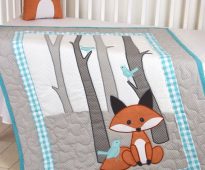 Choosing a blanket for a newborn
Choosing a blanket for a newborn
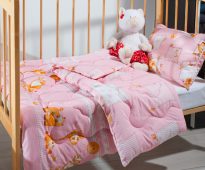 Baby blanket size
Baby blanket size






